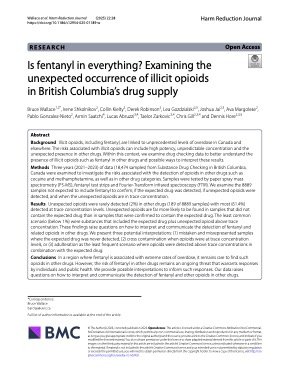By Bruce Wallace, Irene Shkolnikov, Collin Kielty, Derek Robinson, et al.
Background Illicit opioids, including fentanyl, are linked to unprecedented levels of overdose in Canada and elsewhere. The risks associated with illicit opioids can include high potency, unpredictable concentration and the unexpected presence in other drugs. Within this context, we examine drug checking data to better understand the presence of illicit opioids such as fentanyl in other drugs and possible ways to interpret these results. Methods Three years (2021–2023) of data (18,474 samples) from Substance Drug Checking in British Columbia, Canada were examined to investigate the risks associated with the detection of opioids in other drugs such as cocaine and methamphetamine, as well as in other drug categories. Samples were tested by paper spray mass spectrometry (PS-MS), fentanyl test strips and Fourier-Transform infrared spectroscopy (FTIR). We examine the 8889 samples not expected to include fentanyl to confirm; if the expected drug was detected, if unexpected opioids were detected, and when the unexpected opioids are in trace concentration. Results Unexpected opioids were rarely detected (2%) in other drugs (189 of 8889 samples) with most (61.4%) detected at trace concentration levels. Unexpected opioids are far more likely to be found in samples that did not contain the expected drug than in samples that were confirmed to contain the expected drug. The least common scenario (below 1%) were substances that included the expected drug plus unexpected opioid above trace concentration. These findings raise questions on how to interpret and communicate the detection of fentanyl and related opioids in other drugs. We present three potential interpretations: (1) mistaken and misrepresented samples where the expected drug was never detected, (2) cross contamination when opioids were at trace concentration levels, or (3) adulteration as the least frequent scenario where opioids were detected above trace concentrations in combination with the expected drug. Conclusions In a region where fentanyl is associated with extreme rates of overdose, it remains rare to find such opioids in other drugs. However, the risk of fentanyl in other drugs remains an ongoing threat that warrants responses by individuals and public health. We provide possible interpretations to inform such responses. Our data raises questions on how to interpret and communicate the detection of fentanyl and other opioids in other drugs.
Harm Reduction Journal, (2025) 22:28, 8p.





















